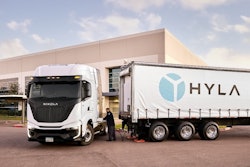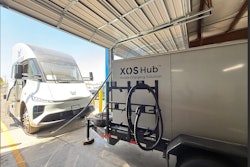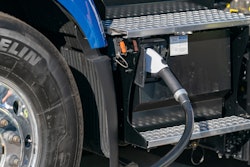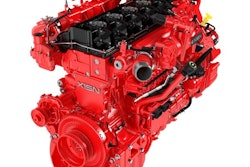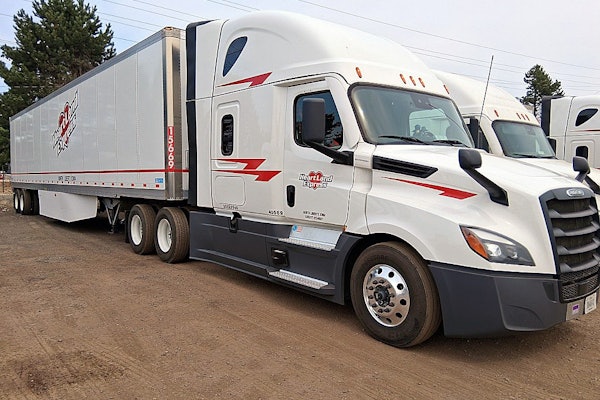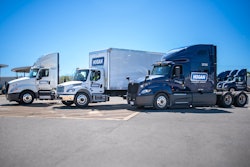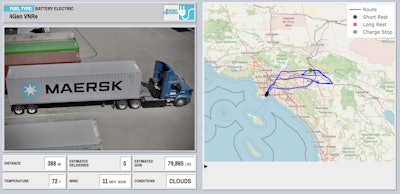
In the memorable words of the W.O.P.R. computer in the 1983 film WarGames, “Would you like to play a game?” How about the game “Range Anxiety?”
Some state trucking organizations, reputable data sources like ATRI and a variety of industry diesel experts like to posit that battery electric trucks can’t go the distances that diesel trucks go. Fair enough.
Take a moment, plan your route from Seattle, Washington, to Bozeman, Montana, on I-90. Your mapping program will tell you that it is 677 miles and will take an estimated 10 hours and 2 minutes. Then day two of your drive from Bozeman to Fargo, North Dakota, on I-94 racks up another 750 miles taking an estimated 10 hours and 29 minutes. Day three of your trucking trip takes you from Fargo on I-94 into Chicago, another 642 miles in 9 hours and 31 minutes. Then take the short hop into Detroit, adding another 289 miles. Then on the fifth day, push on into New York City, adding 614 miles. In five days, you’ve taken your truck the width of the country, accumulating 2,967 legal hours-of-service miles.
Congratulations. You’ve just proven a battery electric truck can’t do what a diesel truck can.
But wait. Like in the movie WarGames, where the computer tries out other scenarios, let’s look at a different route.
Start in Midland, Texas, and head south to Laredo, Texas, racking up a 470 mile day. On day two, run around Laredo picking up loads then head north to Junction, Texas, to complete a 301 mile day. Then on day three head to Santa Teresa, New Mexico, getting in 447 miles. On day four, head to Phoenix, another 473 miles. On day five, push on into San Bernadino, California, adding 293 miles. Five days in a truck, a total of 1,984 miles. Only this time, you were driving an electric truck.
NACFE’s recently completed Run On Less – Messy Middle technology demonstration showcased a mix of trucking technologies in a mix of duty cycles for 13 fleets and 14 trucks in the U.S. and Canada. This included two trucks running on diesels, a third truck running on bio-diesel, another on renewable diesel, three natural gas trucks running on renewable natural gas and hauling loads over 120k GVW, two hydrogen fuel cell trucks, and five battery electric ones.
Take a look at one of those BEVs on the NACFE Run On Less data dashboard. On days 8 through 12, the Joyride Logistics LLC battery electric Windrose truck ran from Midland, to Laredo and then to Phoenix and into LA — a total of 1,984 miles over five days. Along the way, it recharged at available public charging in Texas, New Mexico, Arizona and California. Eight of those were at Electrify America stations located at Walmarts.
Okay, so 1,984 miles in five days is not 2,967 miles. Granted. But it ain’t short haul either.
In North America, multiple agencies have telematics data on trucks. This isn’t survey data, it’s based on actual tracking of where trucks go. The majority of trucks in the U.S. run less than 500 miles per day. Look at your load-boards. I know a couple of drivers who regularly grab 600+ miles a day loads, but most do not. In a 2024 report based on actual telematics data, Geotab found that “58% of medium-duty and 46% of heavy-duty trucks never exceeded 200 miles daily.”
Some diesel advocates often over-emphasize the narrative about long-haul trucking, giving the impression that all Class 8 trucks run more than 600 miles per day and they all are running heavy at 80,000 lbs. maximum weights. Facts don’t seem to bother those people. The reality is that the average truck loading is often less than 70,000 lbs., that anywhere from one-tenth to half the time the trucks are running empty back hauls. And especially, they ignore all the telematics data out there from multiple credible sources that show that most trucks are operating less than 500 miles per day.
It’s called misinformation, and it has served vested interests very well. But facts are facts. Battery electric trucks can go the distance. They are not going to replace every truck on the road...yet. But the new trucks, such as the Windrose and Tesla Semi, are showing they can exceed 400 miles per charging session. Fleets that want to make these trucks work use en route charging at available charging stations and go the distance.
A Saia Tesla Semi running between Stockton, California, and Bakersfield, California, in Run On Less was regularly racking up 400 mile days. Looking at the Run’s days 8 through 11, the truck accumulated 1,676 miles in four days.
The 4Gen Logistics Volvo VNR Electric truck in the Run running drayage between the Port of Long Beach and the Inland Empire was exceeding 300 miles per day. Look at the Run’s days 2, 11 or 18 for examples.
The Nevoya Freightliner eCascadia on Run day 18 had a 318 mile run made possible with enroute charging running between Fresno and Stockton.
These four fleets want what all fleets want: for the truck do the job they assign it. What they are doing right is not listening to the people who say the trucks can’t go the needed distances. Instead they are trying to maximize the potential of these BEVs in their operations.
Yes, battery electric trucks cannot do every job a diesel does. But Joyride, Saia, 4Gen Logistics and Nevoya are examples of many fleets that are making these trucks go the distance. Unlike the conclusion of the movie WarGames, the way to win is to play.




